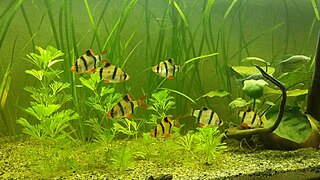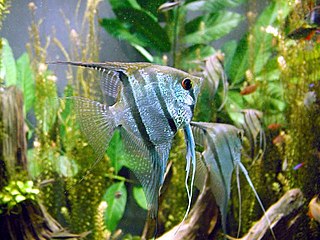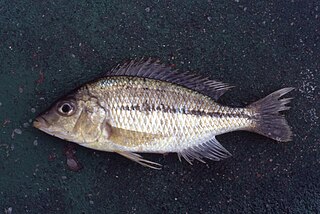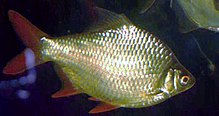
Arowanas are freshwater bony fish of the subfamily Osteoglossinae, also known as bony tongues. In this family of fish, the head is bony and the elongated body is covered by large, heavy scales, with a mosaic pattern of canals. The dorsal and anal fins have soft rays and are long based, while the pectoral and ventral fins are small. The name "bonytongues" is derived from a toothed bone on the floor of the mouth, the "tongue", equipped with teeth that bite against teeth on the roof of the mouth. The arowana is a facultative air breather and can obtain oxygen from air by sucking it into its swim bladder, which is lined with capillaries like lung tissue.

The tiger barb or Sumatra barb, is a species of tropical cyprinid fish. The natural geographic range reportedly extends throughout the Malay Peninsula, Sumatra and Borneo in Indonesia, with unsubstantiated sightings reported in Cambodia. Tiger barbs are also found in many other parts of Asia, and with little reliable collection data over long periods of time, definite conclusions about their natural geographic range versus established introductions are difficult. Tiger barbs may sometimes be confused with Puntigrus anchisporus, Puntigrus navjotsodhii, or Puntigrus partipentazona, which are similar in appearance, the only differences being the slightly different stripe pattern and the number of scales these fish have.

The checker barb is a species of cyprinid fish endemic to creeks, rivers, and lakes in Sumatra, Indonesia. It has also been established in the wild in Colombia. The adult males have red fins with black tips. It will grow up to a length of 5 centimetres (2.0 in) TL. This species is the only known member of its genus.

The black ruby barb or purplehead barb is a tropical cyprinid fish endemic to Sri Lanka, where it occurs in forested streams from the Kelani basin to the Nilwala basin. They are found in streams on hills around 1000 ft in elevation. The brightly colored population introduced to Mahaweli at Ginigathena, Sri Lanka, is said to have diminished in number due to the aquarium export trade.

Pterophyllum is a small genus of freshwater fish from the family Cichlidae known to most aquarists as angelfish. All Pterophyllum species originate from the Amazon Basin, Orinoco Basin and various rivers in the Guiana Shield in tropical South America. The three species of Pterophyllum are unusually shaped for cichlids being greatly laterally compressed, with round bodies and elongated triangular dorsal and anal fins. This body shape allows them to hide among roots and plants, often on a vertical surface. Naturally occurring angelfish are frequently striped transversely, colouration which provides additional camouflage. Angelfish are ambush predators and prey on small fish and macroinvertebrates. All Pterophyllum species form monogamous pairs. Eggs are generally laid on a submerged log or a flattened leaf. As is the case for other cichlids, brood care is highly developed.

The clipper barb or Congo barb is a freshwater and brackish tropical fish belonging to the minnow family (Cyprinidae). Its native habitat is from Côte d'Ivoire through the Chad Basin to Nigeria and Cameroon. It was originally described as Barbus callipterus by Boulenger in 1907.

Polypterus senegalus, the Senegal bichir, gray bichir or Cuvier's bichir, and sometimes called the "dinosaur eel", "dinosaur bichir", or "dragon fish" is in the pet trade due to its lungfish-like appearance, which was described as more primitive and prehistoric than other modern fishes. It is a prototypical species of fish in the genus Polypterus, meaning most of its features are held across the genus. It is commonly kept in captivity by hobbyists. They are native from Africa where they are the most widespread species of the genus.
Community aquaria are tanks that are designed to contain more than one species of fish. Most commonly they include a variety of species that do not normally occur together in nature, for example angelfish from Brazil, swordtails from Mexico, and gouramis from South East Asia. The aim of such communities is to bring together fish that are compatible in temperament and water requirements, while using their different colours and behaviors to add interest and entertainment value.

The harlequin rasbora is a small fish in the family Cyprinidae. The species became an instant favorite among aquarists after its introduction in the early 1900s and is the best known and most widely kept species among the rasboras. In 1935, an image of a trio of harlequin rasboras, stamped in 14k gold, would grace the cover of the first edition of William T. Innes's classic Exotic Aquarium Fishes and would remain so through all 19 editions.

The ram cichlid, Mikrogeophagus ramirezi, is a species of freshwater fish endemic to the Orinoco River basin, in the savannahs of Venezuela and Colombia in South America. The species has been examined in studies on fish behaviour and is a popular aquarium fish, traded under a variety of common names, including ram, blue ram, German blue ram, Asian ram, butterfly cichlid, Ramirez's dwarf cichlid, dwarf butterfly cichlid and Ramirezi. The species is a member of the family Cichlidae and subfamily Geophaginae.

Pethia stoliczkana is a fresh water tropical cyprinid fish native to the upper Mekong, Salwen, Irrawaddy, Meklong and upper Charo Phraya basins in the countries of Nepal, India, Pakistan, Myanmar, Bangladesh, Laos, Thailand, China and Sri Lanka.

Barbonymus is a ray-finned fish genus in the family Cyprinidae, containing some barb species. The genus was only established in 1999, with the tinfoil barb as type species; thus, these fish are sometimes collectively called tinfoils. The new genus was established in recognition of the fact that some large Asian "barbs", formerly rather indiscriminately lumped in Barbus, Barbodes and Puntius, form a distinct evolutionary lineage.

Pelvicachromis pulcher is a freshwater fish of the cichlid family, endemic to Nigeria and Cameroon. It is popular amongst aquarium hobbyists, and is most commonly sold under the name kribensis, although it has other common names, including various derivatives and color morphs of the kribensis: krib, common krib, red krib, super-red krib and rainbow krib, along with rainbow cichlid and purple cichlid.

Mikrogeophagus altispinosus is a species of fish endemic to the Amazon River basin in Brazil and Bolivia. The species is part of the family Cichlidae and subfamily Geophaginae. It is a popular aquarium fish, traded under the common names Bolivian butterfly, Bolivian ram, Bolivian ram cichlid, and ruby crown cichlid.

The eyespot rasbora is a small fish belonging to the Family Cyprinidae, subfamily Danioninae, which is known by the common names of ocellated rasbora, hi-spot rasbora, and eye-spot rasbora, an allusion to the marking situated upon the dorsal fin. This small fish is a popular aquarium fish, having been one of the species featured in the landmark textbook Exotic Aquarium Fishes by Dr William T. Innes. Its appearance in this work only occurs in later editions of the book, however, therefore the species is not subject to the same degree of aquarium domestication as the more familiar harlequin rasbora.

Farlowella acus is the type species of the armored catfish genus Farlowella. Members of this genus are commonly known as twig catfish or whiptail catfish. The specific name of the species, acus, means “pointed” or a “needle” or “spine”.

Protomelas kirkii is a species of cichlid endemic to Lake Malawi where it is most commonly found in areas vegetated with Vallisneria. This species can reach a length of 18 centimetres (7.1 in) TL. This species can also be found in the aquarium trade.
Dactylogyrus is a genus of monogeneans in the Dactylogyridae family.

The Odessa barb is a species of cyprinid fish known from Central Myanmar, where it is known to occur in an artificial pond above the Anisakan Falls and also from the lower Chindwin River. For many years it has been known to the aquarium hobby, where it has frequently been confused with the less colourful ticto barb, but it was only described scientifically in 2008.

The Java barb, more commonly known as silver barb in aquaculture, is a species of ray-finned fish in the genus Barbonymus.





















